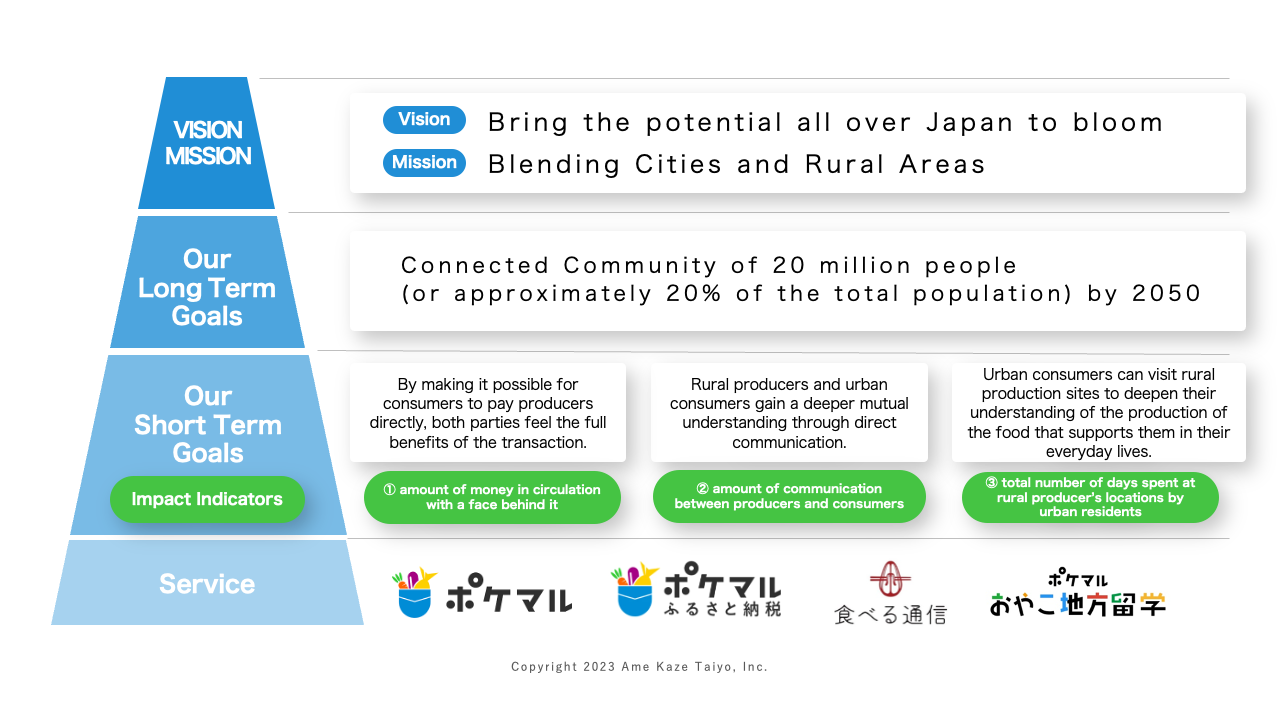Japan through a Connected Community and its impact.
Connected Community is a term* that refers not to the ‘Local Community’ of people who have come to live in a region, nor is it a term that refers to ‘Exchange Community’ of people who visit a region for tourism purposes, rather it refers to a group of people who are involved (and connected) with a rural area across a range of fields. This concept was devised by Mr. Takahashi, the CEO of Ame Kaze Taiyo, Inc., and was first revealed in Mr. Takahashi’s book “Blending Cities and Rural Areas”, that was published in Japan in 2016.
It has now become a signature policy for regional revitalization, and efforts are being made to create a Connected Community across administrative ministries and agencies, including the Ministry of Land, Infrastructure, Transport and Tourism, Ministry of Internal Affairs and Communications, Ministry of Agriculture, Forestry and Fisheries, Ministry of Education, Culture, Sports, Science and Technology, and the Cabinet Office.
The aim of Ame Kaze Taiyo, Inc. is to connect various locations across Japan (including connecting cities and rural areas) by creating a ‘Connected Community’.
We believe that a Connected Community will bring ‘a rich life connected to the countryside and nature’ to those in cities, and ‘countryside living made sustainable by visits of a wide variety of people from cities’ to rural areas. Based on this belief we are engaging in businesses that will expand the Connected Community such as our farm-to-table e-commerce platform ‘Pocket Marché’ and ‘Pokemaru Parent and Child Study Programs’ etc.
*Excerpt from the Ministry of Internal Affairs & Communications “Connected Community Portal Site”

At Ame Kaze Taiyo, Inc., we view the creation of a Connected Community as impactful and aim to grow the Connected Community to 20 million people by 2050.
Impact to us refers to “the social and environmental outcomes resulting from the projects or activities, including short-term and long-term changes engage in”*1. In other words, it is the “positive impact we can have on society”
So, how will “creating a Connected Community” have a positive impact on society?
In Japan’s current society, the population is in continued decline, and it is forecast that the population will decrease from 126 million in 2022 to 105 million in 2050, making for a decrease of approximately 20 million. *4
This population decline has a particularly major impact on rural areas. If this decline in the number of available workers and the outflow of human resources to cities continues, not only will the region lose its vitality, but it will also be at risk of losing its attractive features such as its nature, history, and culture.
When faced with this issue, we believe that a Connected Community is key.
If the number of people that are involved in and connected to rural areas increases, there will be an increase in traffic from cities, and therefore an improvement in economic activity helping the region become more sustainable.
According to current statistics from the Ministry of Land, Infrastructure, Transport and Tourism, 8.61 million people*2, (or 18.4% of approximately 46.78 million people living in Japan’s three major metropolitans) are part of the Connected Community and have a continued relationship with rural areas. The economic impact of this segment of the population is estimated to be approximately 8.1 trillion JPY*3 annually. Ame Kaze Taiyo, Inc.’s goal is to achieve a Connected Community of 20 million people (or approximately 20% of the total population) by 2050, and the expected economic impact is approximately 18,848.1 billion JPY*5.
In order to preserve attractive regions and a diverse Japanese society, Ame Kaze Taiyo, Inc. is working to grow a Connected Community.
In order to reach a Connected Community of 20 million people, Ame Kaze Taiyo, Inc. will create “connections between producers and consumers” through our various business activities. We hope that these connections will lead to a Connected Community that is involved across a variety of spectrums with rural communities.
In order to achieve this, at Ame Kaze Taiyo, Inc. we have identified three indicators linked to Connected Community growth. These indicators are the ‘amount of money in circulation with a face behind it’, the ‘amount of communication between producers and consumers’, and the ‘total number of days spent at rural producer’s locations by urban residents.’
We will hold these three indicators to the same level of importance as our financial statements in the operation of our business.


